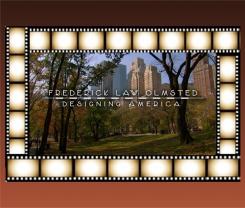Adult Services will be holding a Dinner & a Movie! event on Friday, February 14th at 6:30 p.m. in Mtg. Rm. B The movie will be one of this year's Oscar nominees: Judy starring Renee Zellweger will be shown and pizza will be served! Registration is required for this event and it begins on Monday, February 10th at 9:30 a.m.
Our Take On: Frederick Law Olmsted: Designing America
Chief among the places he’s famous for, is New York City’s Central Park, which he co-designed with his senior partner Calvert Vaux. Some JBF members already knew this, but were interested to learn that Olmsted started out as a journalist. Both before and during the Civil War he was to vivid first-person social documents of the pre-war South. What he learned while visiting there shifted his views from neutral to abolitionist, and he was very outspoken about it.
We talked about how his travels and enthusiasm for farming and shaping the land led to his studies for structuring parks and we sympathized with his stress over the political power players who at times had a disheartening effect on project budgets without appreciating the long view Olmsted had for what his designs could grow into. We thought the film did an excellent job of detailing the many instances where he established the base for a park that has enabled it to grow and work around the space needs of a city’s people to the present day. We learned that he is the inventor of the “greenway” concept still used today to create a series of linked parks in an area. Olmsted’s park and parkway system in Buffalo, N.Y. is the oldest integrated system in America and is listed on the National Register of Historic Places.
He used this principle in saving the Back Bay area of Boston. During the Industrial Revolution of the early 19th Century, the natural beauty of Niagara Falls began to suffer as earnest industrialists built mills and factories along the river to harness its power. Olmsted led a small band of early environmentalists who were concerned over the river’s waning flow, founded the Free Niagara movement. The movement believed that the natural beauty of the land surrounding the Falls should be protected from commercial interests and exploitation, and remain free to the public. After 15 years, the members won their battle, and Olmsted was able to apply his philosophy that such areas are places of natural beauty, where “the masses could be renewed.” In fact Olmsted firmly believed that park goers should dress up for the occasion – but he understood the need for leisure activities in the park as well. Olmsted’s landscape design for Niagara Falls State Park has an entire network of footpaths through wooded areas and along the banks of the Niagara River. As they said in the film, people go to the Canadian side to look back at the beauty Olmsted shepherded in creating this park.
Understandably, three of our favorite projects was Riverside in Illinois, and Jackson Park in Chicago. It impressed us that Riverside is arguably the first planned community in the United States, designed in 1869 by Calvert Vaux and Frederick Law Olmsted. Yet another way Olmsted was a trail-blazer in the ecological aspects of city growth. We talked about the lagoons, and how easy it is to be in one of his parks and forget you’re even in a city. Members talked about visiting the Wooded Island, which Olmsted created by dredging the land for the lagoons and planting trees on it. Olmsted also influenced the planning and creation of “the Midway” a.k.a. “Midway Plaisance”. Laid out with long vistas of avenues with trees, it was inspired by Central Park.
It was a pleasure to learn more about the man whose involvement with establishing landscape architecture as a profession is amply supported by the major parks and structures that he built which are still standing – and used today. We concluded that people could justifiably regard him as the first leader of the Green movement in the United States, and that we all wanted to visit one of his parks immediately – or at least the ones in our own neighborhoods!
NOTE We also saw Part 1 of our last documentary: "SuperHeroes: A Never-Ending Battle". The summary of Part 1 will be in the April discussion summary.
















Add new comment